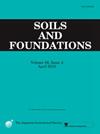In-situ investigation on installation mechanisms of pre-bored grouted planted piles in deep and thick sand layers
IF 3.3
2区 工程技术
Q2 ENGINEERING, GEOLOGICAL
引用次数: 0
Abstract
Due to merits of low noise and vibration, the pre-bored planted method has been widely used in engineering practice to assist the installation of the prestressed high-strength concrete (PHC) piles in area where deep and thick sand layers are commonly encountered. However, the research on the influence mechanism of pile driving methods in hard soil layers mainly focuses on the static pressing method and the hammering method, while the penetration characteristics under pre-bored assistance remains unclear. Therefore, a full-scale field test was conducted to investigate the installation effects. The penetration mechanisms of the piles with pre-bored assistance in areas with a deep and thick sand layer was discussed. Besides, an analytical method was proposed to predict the energy (hammer blow counts) necessary to drive pile to design depth. The results showed that the pre-bored grouted planted method significantly reduced the energy required for pile driving, compared to both the hammering method and the pre-bored planted method. This was because pre-drilling reduced displaced soil volume and relieved lateral stress. The pile load transfer mechanism was optimized by pre-drilling, which effectively leveraged the high compressive strength of the deep and thick sand layers. Meanwhile, the shaft friction within the grouted depth was significantly enhanced by the permeation, cementation and reinforcement effects of the concrete slurry, thereby improving the pile bearing capacity. Furthermore, the analytical method proposed based on the cavity expansion theory was capable of predicting the energy required for pile driving, which could guide the selection of pile driving equipment with minimum energy consumption and prevent pile damage caused by excessive hammering.
深厚砂层中预钻孔灌注桩安装机理的现场研究
预钻孔灌注法由于具有低噪声、低振动的优点,在工程实践中广泛应用于深厚砂层地区的预应力高强混凝土桩的辅助安装。然而,硬土层中打桩方式影响机理的研究主要集中在静压法和锤击法,预钻辅助下的沉贯特性尚不清楚。因此,进行了全尺寸的现场试验来研究安装效果。探讨了预钻辅助桩在深厚砂层地区的侵彻机理。此外,提出了一种预测打入桩至设计深度所需能量(锤击次数)的分析方法。结果表明,与锤击法和预钻孔灌注法相比,预钻孔灌注法明显降低了打桩所需的能量。这是因为预钻减少了位移土体积,减轻了侧向应力。通过预钻优化桩基荷载传递机制,有效利用深、厚砂层的高抗压强度。同时,在灌浆深度内,混凝土浆体的渗透、胶结和加固作用显著增强了桩身摩擦力,从而提高了桩身承载力。此外,基于空腔扩展理论提出的分析方法能够预测打桩所需的能量,可以指导选择能耗最小的打桩设备,防止过度锤击造成桩的损坏。
本文章由计算机程序翻译,如有差异,请以英文原文为准。
求助全文
约1分钟内获得全文
求助全文
来源期刊

Soils and Foundations
工程技术-地球科学综合
CiteScore
6.40
自引率
8.10%
发文量
99
审稿时长
5 months
期刊介绍:
Soils and Foundations is one of the leading journals in the field of soil mechanics and geotechnical engineering. It is the official journal of the Japanese Geotechnical Society (JGS)., The journal publishes a variety of original research paper, technical reports, technical notes, as well as the state-of-the-art reports upon invitation by the Editor, in the fields of soil and rock mechanics, geotechnical engineering, and environmental geotechnics. Since the publication of Volume 1, No.1 issue in June 1960, Soils and Foundations will celebrate the 60th anniversary in the year of 2020.
Soils and Foundations welcomes theoretical as well as practical work associated with the aforementioned field(s). Case studies that describe the original and interdisciplinary work applicable to geotechnical engineering are particularly encouraged. Discussions to each of the published articles are also welcomed in order to provide an avenue in which opinions of peers may be fed back or exchanged. In providing latest expertise on a specific topic, one issue out of six per year on average was allocated to include selected papers from the International Symposia which were held in Japan as well as overseas.
 求助内容:
求助内容: 应助结果提醒方式:
应助结果提醒方式:


